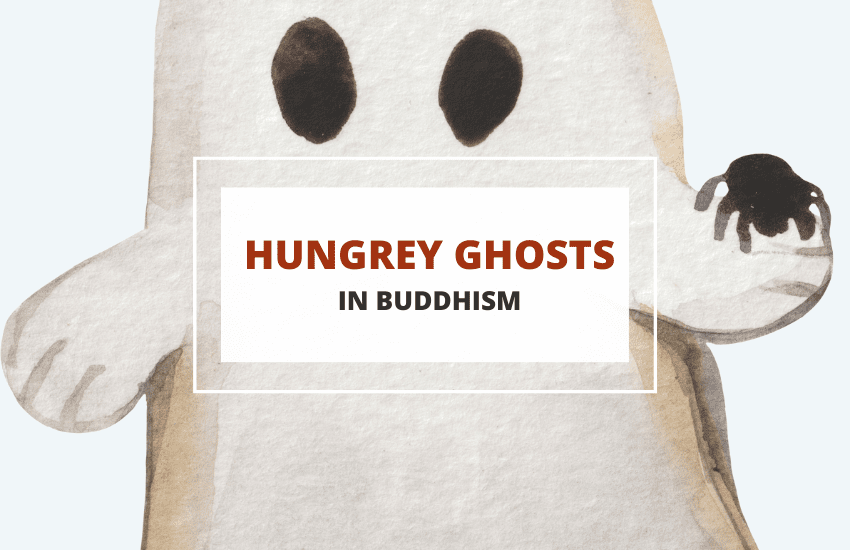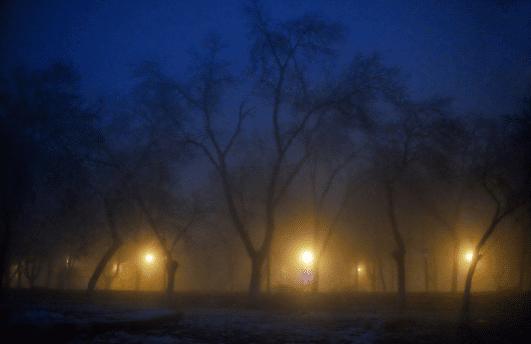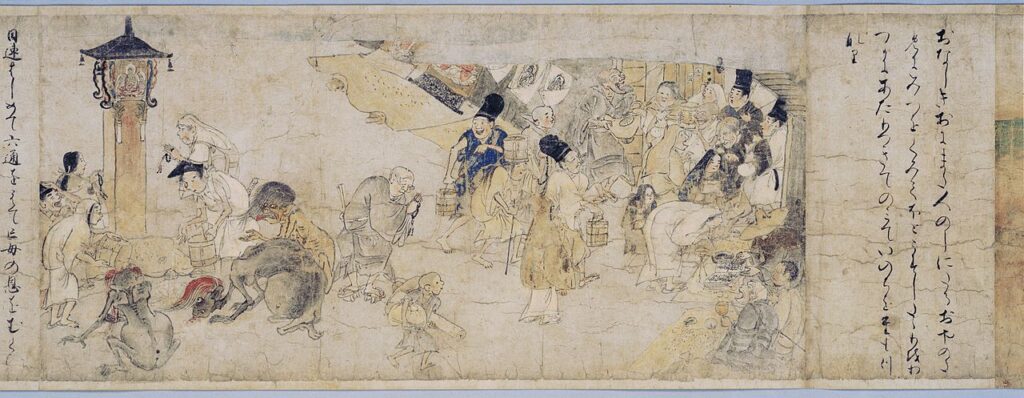
Table of Contents
In Western society, Buddhism is commonly associated with non-violence, meditation, and calmness. But human nature is nothing like that, and people of all religions are oftentimes driven by hunger and desire.
In Buddhism, those who regularly succumb to their lowest desires are reincarnated as hungry ghosts, one of the most wretched, interesting, and overlooked entities of the Buddhist religion.
Descriptions of Hungry Ghosts in Religious Texts
The best description of hungry ghosts comes from a collection of Sanskrit texts known as Avadanasataka, or Century of Noble Deeds. It probably dates to the 2nd century CE and is part of the Buddhist Avadana literary tradition, which consists of stories about notable lives and biographies.
In these texts, the process of reincarnation based on the life path or karma one followed when alive is explained, and so is the apparent form of all the possible incarnations. Hungry ghosts are described as humanoid spirits with dry, mummified skin, long and skinny limbs and necks, and bulging stomachs.
Some hungry ghosts lack a mouth entirely, and others do have one, but it is very small as a punishment to cause them unrelenting hunger.
What Sins Turn You into a Hungry Ghost?

Hungry ghosts are the wretched souls of people who have been greedy during their lifetime. Their curse is, accordingly, to be forever starving. Furthermore, they can only eat one type of food, specific to their main lifetime sins.
These sins, as described in the Avadanasataka, are also quite specific. For instance, one sin is if a woman lies about not having food to share with passing soldiers or monks. Not sharing food with your spouse is also a sin, and so is sharing ‘impure’ food, such as giving meat to monks who are forbidden to eat parts of animals. Most sins related to food turn you into a hungry ghost that can only eat disgusting foods, like excrement and vomit.
More conventional sins such as stealing or swindling will grant you the form of a shape-shifting ghost, who will only be able to eat food that has been stolen from houses.
Ghosts that are always thirsty are the souls of those merchants who water down the wine they sell. There are in total 36 types of hungry ghosts, each with their own sins and their own foods, which include toddlers, maggots, and smoke from incense.
Where Do Hungry Ghosts Live?

The itinerary of a soul in Buddhism is complicated. Souls are endless and trapped in a never-ending cycle of birth, death, and rebirth called the Samsara, which is usually represented as a turning wheel.
Human beings are considered to be a step below gods, and if their karma goes along with their dharma (their true, or intended, life path), after their demise they will be reincarnated as human beings and live on earth.
A select few wills, through the performance of great deeds and flawless and pious life, become buddhas and live in heaven as gods. On the other end of the spectrum, the lowest of humans will die and be reborn in one of the multiple hells, at least until their karma has depleted and can incarnate in a slightly better place.
Hungry ghosts, on the other hand, reside neither in hell nor in heaven, but right here on earth, and are cursed with a pitiful afterlife among humans but unable to fully interact with them.
Are Hungry Ghosts Harmful?
As we have seen, becoming a hungry ghost is a punishment for the condemned soul, not for the rest of the living beings. They can be a nuisance for the living, as hungry ghosts are never satisfied and must always seek gratuity from people.
Some people say they bring bad luck to those who live near a hungry ghost. Certain types of hungry ghosts can and will possess men and women, especially those who are weak-willed because their bodies are more suited to eating and drinking than those of the hungry ghosts themselves.
Possessed individuals suffer from stomach illnesses, vomiting, frenzies, and other symptoms, and getting rid of a hungry ghost can be very difficult once it is lodged in someone’s body.
Hungry Ghosts in Other Religions
Not only Buddhism has entities similar to the ones described in this article. Likened religions like Taoism, Hinduism, Sikhism, and Jainism all have a category of ghosts who are cursed with insatiable hunger and desire because of the bad choices they made while alive.
Belief in this kind of spirit is found from the Philippines to Japan and Thailand, also mainland China, Laos, Burma, and of course India and Pakistan. Christianity and Judaism have a form of the hungry ghost as well, and it is mentioned in the Book of Enoch as the ‘Bad Watchers’.

The story says these angels were sent by God to earth with the purpose of watching over humans. However, they started to lust over human women and steal food and riches. This earned them the title of ‘bad’ watchers, although the Second Book of Enoch gives them a proper name as Grigori. At one point, the bad watchers procreated with humans, and a race of dangerous giants known as Nephilim was born.
These giants wander the earth craving food, although they lack mouths, and so they are cursed with not being able to properly feed despite being permanently hungry. The parallels between the bad watchers and the Buddhist hungry ghosts are obvious, but also rather superficial, and indeed it is highly doubtful that the two stories have a common source.
Contemporary Interpretations and Cultural Impact
In modern times, the concept of hungry ghosts continues to resonate culturally and spiritually. It finds expression in festivals like the Ghost Month and the Hungry Ghost Festival in various Asian communities, where rituals are performed to appease these spirits.
These contemporary practices reflect a rich tapestry of cultural adaptation and serve as a social mechanism for addressing themes of compassion and communal responsibility. Such observances highlight the enduring relevance of hungry ghosts in imparting life lessons and fostering social harmony.
Wrapping Up
Hungry ghosts come in different sizes and forms, and while most are harmless, some of them can cause living pain or bad luck.
As a metaphor for addiction or promiscuity, they serve as reminders for Buddhists all over the world that their actions during life will eventually catch up to them.
Many different sins exist, and many different kinds of hungry ghosts are described in Sanskrit texts in order to make people follow their dharma more closely.








